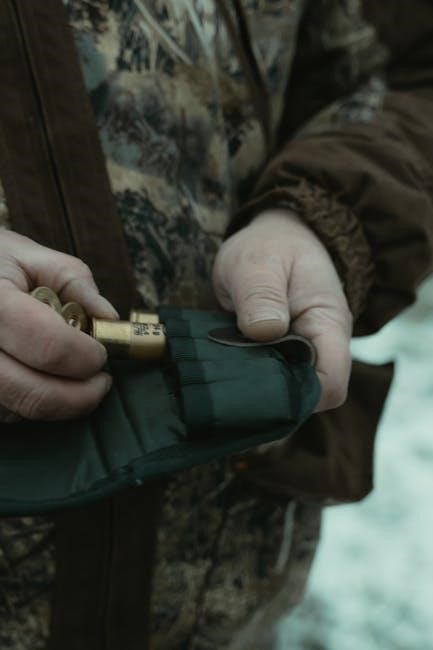1․1 Overview of the Hunter Ceiling Fan Manual
The Hunter Ceiling Fan manual provides comprehensive installation, operation, and maintenance instructions․ It ensures safety, optimal performance, and troubleshooting guidance, making it essential for users of all skill levels․
The Hunter Ceiling Fan manual is a detailed guide designed to help users install, operate, and maintain their ceiling fans effectively․ It covers essential topics such as safety precautions, installation steps, and troubleshooting common issues․ The manual emphasizes the importance of proper installation to ensure optimal performance and energy efficiency․ It also provides instructions for adjusting fan settings, reversing fan direction for seasonal use, and maintaining the fan’s appearance and functionality․ Additionally, the manual includes warranty information and guidelines for registering the product․ By following the manual’s instructions, users can enjoy a comfortable and energy-efficient experience while extending the lifespan of their ceiling fan․ The manual is available for download in PDF format, making it easily accessible for reference․
1․2 Importance of Reading the Manual
Reading the Hunter Ceiling Fan manual is crucial for ensuring safe and proper installation, operation, and maintenance of your ceiling fan; The manual provides essential safety precautions to avoid electrical hazards and ensures optimal performance․ It outlines step-by-step installation guidelines, helping users avoid common mistakes that could damage the fan or compromise its efficiency; Additionally, the manual explains how to adjust settings, reverse fan direction for seasonal use, and troubleshoot common issues․ Understanding the manual’s content helps users maximize energy efficiency and extend the fan’s lifespan․ It also includes warranty information and product registration details, ensuring customers can access support when needed․ By following the manual, users can enjoy a safe, comfortable, and energy-efficient experience with their Hunter Ceiling Fan․ Regular reference to the manual ensures proper maintenance and operation, preventing potential problems and enhancing overall satisfaction․

Installation
The installation process requires careful preparation and adherence to safety guidelines․ Ensure all tools and materials are ready, and follow step-by-step instructions for a secure and proper setup․

2․1 Pre-Installation Checks
Before starting the installation, ensure the ceiling is structurally sound to support the fan’s weight․ Verify electrical requirements match the fan’s specifications, including voltage and wattage․ Check that all necessary tools and materials are available․ Read the manual thoroughly to understand instructions and safety precautions․ Ensure compliance with local building codes and regulations․ Inspect the fan components for any damage or defects․ Confirm the power supply is turned off at the circuit breaker before handling any wiring․ Measure the ceiling height to ensure proper clearance and airflow․ Familiarize yourself with the mounting hardware and ensure all parts are included․ Double-check the fan’s compatibility with your ceiling type, such as flat or sloped ceilings․ Address any potential issues before proceeding to avoid complications during installation․ Proper preparation ensures a safe and efficient setup․
2․2 Tools and Materials Needed
To install your Hunter ceiling fan, gather the necessary tools and materials to ensure a smooth process․ Essential tools include a screwdriver (both Phillips and flathead), a wrench or pliers for tightening connections, a ladder or step stool for safe access, and wire strippers for electrical connections․ Additional tools like a voltage tester and measuring tape may be helpful․ Required materials include the fan mounting hardware (provided in the box), screws for securing the fan, washers to prevent damage, and wire connectors for safe electrical hookups․ Ensure all parts from the fan box are accounted for, such as the motor housing, blades, and remote control components (if applicable)․ Having these tools and materials ready will streamline the installation process and minimize delays․ Proper preparation is key to a successful and safe setup․
2․3 Mounting Options and Requirements

The Hunter ceiling fan offers versatile mounting options to suit various ceiling types and designs․ The standard mounting bracket is suitable for flat ceilings, while the angled mounting kit allows installation on sloped or vaulted ceilings․ For low-ceiling applications, a flush mount option is available to minimize clearance․ Ensure the mounting hardware is compatible with your ceiling type and weight capacity․ The fan must be installed on a sturdy electrical box rated for the fan’s weight․ For angled ceilings, additional support brackets may be required․ Always follow the manufacturer’s specifications for mounting to ensure safety and stability․ Proper mounting is crucial for optimal performance and to prevent potential hazards․ Refer to the manual for detailed guidance on selecting the appropriate mounting method for your ceiling configuration․ This ensures a secure and balanced installation․
2․4 Wiring and Electrical Connections
Proper wiring and electrical connections are critical for safe and efficient operation of your Hunter ceiling fan․ Before starting, ensure the power is turned off at the circuit breaker or fuse box․ Use a voltage tester to confirm there is no electricity flowing to the wires․ Identify the black (hot), white (neutral), and copper (ground) wires․ Connect the black wire to the fan’s motor wires, the white wire to the neutral wires, and the copper wire to the grounding terminal․ If your fan includes a lighting kit or remote control, additional wires may be present; consult the manual for specific instructions․ Secure all connections with wire nuts or electrical tape․ Ensure the wiring is neat and tucked into the ceiling box to avoid interference․ Proper grounding is essential to prevent electrical hazards․ If unsure, consult a licensed electrician to ensure compliance with local codes and safety standards․

2․5 Assembling the Fan Components
Assembling your Hunter ceiling fan components is a straightforward process when done systematically․ Start by unpacking all parts and ensuring no items are damaged or missing․ Use the hardware bag to organize screws, clips, and other small parts․ Attach the fan blades to the blade arms, ensuring they are securely fastened with the provided screws․ Next, assemble the motor housing by aligning the housing covers and tightening the screws evenly․ If your fan includes a light kit or additional features, follow the manual’s specific instructions for installation․ Mount the hanger bracket to the motor housing, ensuring it is level and stable․ Finally, attach the fan blades to the motor by inserting the blade arms into their respective slots and tightening the screws․ Double-check all connections for tightness and balance before proceeding to installation․ Always refer to the manual for exact assembly steps tailored to your fan model․

Operation
Operating your Hunter ceiling fan is simple and efficient․ Turn the fan on/off using the pull chain or remote control․ Adjust the speed settings based on your preference․ Change the fan direction for seasonal airflow optimization․ Ensure the fan blades are secure and clean before operation․ Always follow the manual’s guidelines for optimal performance and energy efficiency․ Regular maintenance will ensure smooth operation․
3․1 Operating the Fan: An Overview
Operating your Hunter ceiling fan is straightforward and designed for ease of use․ Begin by ensuring the fan is properly installed and all components are securely in place․ Use the pull chain or remote control to turn the fan on and off․ The fan typically features multiple speed settings, which can be adjusted based on your comfort needs․ For optimal airflow, consider changing the fan’s direction depending on the season—counterclockwise for summer to circulate cool air and clockwise for winter to redistribute warm air․ Always ensure the blades are balanced and clean to maintain smooth operation․ Refer to the manual for specific instructions tailored to your model, as some fans may have additional features like timers or smart home integration․ Proper operation ensures energy efficiency and minimal noise․ Regular checks and maintenance will help sustain its performance․
3․2 Adjusting Speed Settings
Adjusting the speed settings on your Hunter ceiling fan is simple and convenient․ Most models come with a pull chain or remote control, allowing you to choose from multiple speed options․ Typically, fans have low, medium, and high settings to suit different airflow needs․ To adjust the speed, pull the chain or press the corresponding button on the remote․ Some models may also feature smart home integration, enabling you to adjust speeds via a mobile app․ For energy efficiency, consider using lower speeds for mild days and higher speeds for warmer or cooler periods․ Always ensure the fan is turned off before cleaning or performing maintenance․ Proper speed adjustment ensures optimal airflow and energy savings․ Regularly check the manual for specific instructions, as certain models may offer additional features like eco-mode or silent operation․
3․3 Changing Fan Direction for Seasons
Changing the direction of your Hunter ceiling fan based on the season is an energy-efficient way to enhance comfort․ During winter, reversing the fan direction helps circulate warm air that rises to the ceiling back down into the room․ In summer, the normal fan direction creates a cooling breeze․ To change the direction, locate the reverse switch, usually found on the fan’s motor housing or remote control․ Turn off the fan before switching to avoid damage; Flip the switch and restart the fan to ensure proper airflow․ This feature optimizes air circulation year-round, reducing heating and cooling costs․ Always refer to your manual for specific instructions, as some models may have varying procedures․ Regular direction changes can significantly improve indoor climate control and energy efficiency․
3․4 Using the Remote Control
The remote control for your Hunter ceiling fan offers a convenient way to regulate fan speed and lighting․ First, ensure the remote is properly paired with the fan by following the pairing process outlined in the manual․ Replace the batteries with the specified type, typically CR2032 or similar, to ensure proper function․ To operate, point the remote directly at the fan’s receiver to maintain a clear line of sight․ Use the power button to turn the fan on or off, and adjust the speed using the designated buttons․ If your fan has a light kit, use the corresponding buttons to dim or brighten the lights․ Change fan direction using the reverse button, which is especially useful for seasonal adjustments․ Regularly clean the remote’s buttons and replace batteries as needed to maintain functionality․ Always keep the remote in a secure location to prevent loss or damage․

Maintenance
Regular maintenance ensures optimal performance and longevity of your Hunter ceiling fan․ Clean blades, inspect for wear, and lubricate moving parts as needed to maintain efficiency and safety․
4․1 Cleaning the Fan Blades and Housing
To maintain your Hunter ceiling fan’s efficiency and appearance, regular cleaning is essential․ Turn off the power at the circuit breaker before cleaning․ Use a soft, dry cloth to wipe down the fan blades and housing to remove dust and debris․ For tougher stains or grease buildup, dampen the cloth with a mild detergent solution, but avoid harsh chemicals or abrasive cleaners that could damage the finish․ Never use water directly on electrical components to prevent damage or safety hazards․ For intricate designs or hard-to-reach areas, use a soft-bristle brush or a microfiber cloth․ Cleaning ensures smooth operation and prevents dust from circulating in the air․ Regular maintenance also helps maintain the fan’s aesthetic appeal and prolongs its lifespan․ Always ensure the fan is completely still before starting the cleaning process․
4․2 Lubricating Moving Parts
Lubricating the moving parts of your Hunter ceiling fan is crucial for smooth operation and noise reduction․ Over time, friction in the motor and bearings can cause wear and tear, leading to increased noise and reduced efficiency․ Use a high-quality, silicone-based lubricant specifically designed for ceiling fans․ Avoid using household oils like WD-40, as they may attract dust and degrade over time․ Apply a few drops of lubricant to the motor housing and bearings, following the manufacturer’s instructions․ Ensure the fan is turned off and completely still before lubricating․ Excess lubricant can drip onto the blades or floor, so apply it sparingly․ Regular lubrication, ideally every 6 to 12 months, will help maintain optimal performance and extend the lifespan of your ceiling fan․ Always refer to the Hunter ceiling fan manual for specific lubrication recommendations․
4․3 Inspecting Blades for Damage
Regularly inspecting the fan blades is essential to ensure optimal performance and safety․ Over time, blades may develop damage such as cracks, dents, or warping, which can lead to imbalance and operational issues․ Begin by turning off the fan and allowing it to stop completely․ Visually examine each blade for signs of wear or damage․ Clean the blades to remove dust or debris that might obscure your view․ If you notice any damage, replace the affected blade immediately․ Hunter ceiling fans are designed with interchangeable blades, making replacement straightforward․ For severe damage, consult the manual or contact customer support for guidance․ Regular inspections help maintain balance, reduce wobbling, and ensure quiet operation․ Always prioritize blade maintenance to prolong the lifespan of your ceiling fan and ensure safe use․

Troubleshooting
Identify common issues like the fan not turning on or unusual noise․ Check power sources, connections, and ensure proper installation․ Refer to the manual for detailed solutions and safety guidelines․

5․1 Fan Not Turning On
If your Hunter ceiling fan fails to turn on, first check the power source․ Ensure the fan is properly plugged in and that the circuit breaker or fuse hasn’t tripped․ Verify that the wall switch controlling the fan is in the “on” position․ If using a remote control, replace the batteries and ensure it’s functioning correctly․ Check for loose connections in the wiring, especially between the fan and the receiver․ Refer to the manual for wiring diagrams to confirm all connections are secure․ If the issue persists, inspect the pull chain or switch for damage․ If none of these steps resolve the problem, consult the manual for advanced troubleshooting or contact Hunter’s customer support for assistance․ Always prioritize safety when diagnosing electrical issues․
5․2 Addressing Wobbling Issues
If your Hunter ceiling fan is wobbling, start by ensuring the fan is properly installed․ Check that the mounting bracket is securely fastened to the ceiling and that all screws are tightened evenly․ Verify that the downrod is fully engaged and tightened properly․ If the fan blades are unbalanced, use the balancing kit provided with your fan to adjust them․ Inspect the blades for damage or misalignment and replace any damaged blades․ Ensure the ceiling is level and use shims if necessary to stabilize the fan․ Check that the fan’s hanger bracket is level and adjust it according to the manual․ Finally, confirm that the fan is not too heavy for the mounting bracket․ If wobbling persists, consult the manual or contact Hunter’s customer support for further assistance․ Regular maintenance and proper installation are key to preventing wobbling issues․
5․3 Reducing Operational Noise
To minimize operational noise, ensure all fan components are properly installed and aligned․ Check for loose screws or bolts and tighten them firmly․ Imbalanced blades can cause vibration and noise; use the balancing kit provided to adjust them․ Clean the fan blades regularly to remove dust and debris, which can disrupt airflow and create noise․ Lubricate the fan’s motor bearings with a silicone-based lubricant as recommended in the manual․ Avoid operating the fan at maximum speed unless necessary, as higher speeds often generate more noise․ Ensure the fan is installed on a level ceiling and the mounting bracket is secure․ If the noise persists, inspect the fan’s motor housing for dust buildup and clean it gently with a soft cloth․ Always follow the manufacturer’s guidelines for maintenance and troubleshooting to ensure optimal performance and minimal noise․ Regular care can significantly reduce operational noise over time․

Warranty Information
Hunter ceiling fans come with a limited warranty covering parts and labor for up to one year․ Registration is required for validation․ Contact customer support for claims assistance․
6․1 Understanding the Warranty Terms
The Hunter ceiling fan warranty provides coverage for defects in materials and workmanship under normal use․ The limited warranty typically lasts for one year from the date of purchase and applies to parts and labor․ It does not cover damage caused by misuse, improper installation, or failure to follow maintenance guidelines․ For the warranty to be valid, the fan must be installed by a licensed electrician, and all safety precautions outlined in the manual must be followed․ Coverage extends to the original purchaser only and is non-transferable․ Any modifications or tampering with the fan voids the warranty․ Claims must be submitted in writing, including proof of purchase and a detailed description of the issue․ Hunter reserves the right to repair or replace defective parts at their discretion․
6․2 Registering Your Product
Registering your Hunter ceiling fan is a simple process that ensures warranty validation and provides access to exclusive customer support․ To register, visit the Hunter Fan official website and navigate to the “Product Registration” section․ You will need to provide your personal information, such as name and email, along with your fan’s model number, serial number, and purchase date․ This information can be found in your Hunter ceiling fan manual or on the product packaging․ Once submitted, you will receive a confirmation email․ Registration is crucial for activating your warranty and receiving updates or recalls․ It also streamlines the process for any future service requests․ Ensure your details are accurate to avoid delays․ This step is quick and helps Hunter maintain accurate records for your product․
7․1 Summary of Key Points
This manual has guided you through installing, operating, and maintaining your Hunter ceiling fan․ Key steps include pre-installation checks, proper wiring, and assembly․ Regular cleaning and lubrication ensure smooth operation․ Troubleshooting tips address common issues like wobbling or noise․ Always follow safety guidelines and warranty terms for optimal performance․ By adhering to these instructions, you can enjoy an energy-efficient and durable ceiling fan․
7․2 Final Tips for Optimal Performance
To ensure your Hunter ceiling fan operates at its best, maintain a consistent cleaning schedule to prevent dust buildup․ Always check for loose screws or blades after installation and tighten them as needed․ Use the correct fan direction based on the season to maximize airflow efficiency․ Consider pairing your fan with an energy-efficient light kit to enhance performance․ Regularly inspect the remote control batteries and replace them when necessary․ For optimal airflow, install the fan at the recommended height and ensure proper blade balance․ Avoid overloading the fan with heavy accessories․ By following these tips, you can enjoy a quiet, energy-efficient, and long-lasting ceiling fan experience․ Proper care ensures your Hunter ceiling fan remains a reliable and stylish addition to your home․
